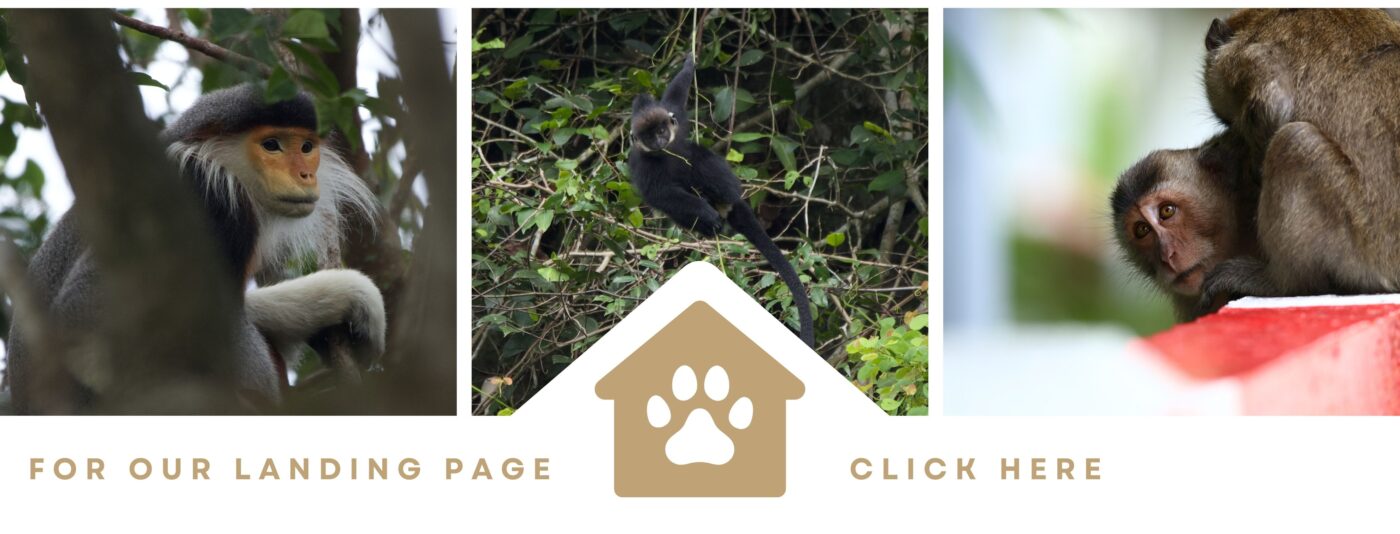Nestled within the breathtaking landscapes of Vietnam, the Cat Ba Langur (Trachypithecus poliocephalus) stands as a living testament to the country’s rich biodiversity. In this exploration, we unveil the intricate details of this endangered primate, delving into its taxonomy, appearance, habitat, behavior, reproductive biology, conservation status, and the crucial need for its protection.

Are you looking for Wildlife Tours in Vietnam?
WANEE VIETNAM is your go-to destination for "Wildlife Tours in Vietnam", specializing in Birding, Primate Watching, Herping, Photography Tours and Educational Tours led by our expert guides.Taxonomy and Classification Cat Ba Langur:
Regnum: Animalia
Phylum: Chordata
Class: Mammalia
Ordo: Primates
Familiar: Cercopithecidae
Genus: Trachypithecus
Species: Trachypithecus poliocephalus ssp.

Belonging to the Trachypithecus genus, the Cat Ba Langur is characterized by its distinctive grayish-black fur, complemented by striking white sideburns and a crown of silver-gray hair atop its head. Their long limbs and prehensile tails enable agile movements through the limestone karst formations, where they call home.

Habitat and Distribution:

The Cat Ba Langur finds solace in the limestone forests of Cat Ba Island, part of the Ha Long Bay archipelago. This unique habitat, characterized by towering limestone cliffs and dense vegetation, creates an ecological niche for the langurs. Unfortunately, their distribution is highly restricted, making them vulnerable to habitat loss and fragmentation.
Behavior and Social Structure:

These langurs exhibit a complex social structure, living in cohesive groups led by a dominant male. They are known for their acrobatic feats as they traverse the karst landscapes, leaping between limestone outcrops. Vocalizations and grooming play a crucial role in communication, fostering social bonds within the group.
Reproductive Biology:

The Cat Ba Langur’s reproductive biology is integral to its survival. Females give birth to a single offspring after a gestation period of approximately six months. Breeding happens through the year with winter months showing a large increase in frequency of births. February and April are the months with the most births. Given the approximately 6-month gestation period this indicates that the peak conception month is August, near the end of the rainy season. The close-knit social structure ensures cooperative care for the young, enhancing their chances of survival in the challenging karst environment.
Conservation Status:

Classified as Critically Endangered by the International Union for Conservation of Nature (IUCN), the Cat Ba Langur faces severe threats. With an estimated population of around 60 individuals, habitat loss, and poaching pose immediate dangers.
Poaching, primarily for traditional “medicine” with secondary hunting for sport, has been recognized as the most severe historical threat to Cat Ba Langurs, and the reason for the precipitous decline in their population over the past decades. Reproductively valuable males were often the most common victims due to their behavior. This is highly questionable, however, as their behavior is not enormously different and, if anything, females would be easier to hunt as they are often grouped together and there are more of them per group.
Habitat disturbance and fragmentation resulting from the growing human population on Cat Ba Island (due in large part to the country’s designation of the island as a new tourism center for northern Viet Nam), and rampant fires due to honey collectors are also threats.
Why don’t you visit Vietnam on a primate discovery tour? Click here.
Conclusion:
In the heart of Cat Ba Island, the Cat Ba Langur epitomizes the fragile beauty of Vietnam’s natural heritage. As we navigate the nuances of its taxonomy, behavior, and conservation status, a rallying cry emerges for collective action. Preserving the limestone karst habitats and ensuring the protection of the Cat Ba Langur are essential steps towards safeguarding this remarkable primate for future generations and sustaining the ecological balance of Vietnam’s unique landscapes.
Crocodile Trail – The Best Birding Trail in Cat Tien National Park
If you’re a birder or nature photographer planning a trip to Vietnam, few places offer [...]
Cong Troi Trail – Top 1 Dalat Plateau Birding Trail Experience
If you’re a birder or nature photographer planning a trip to Vietnam’s Central Highlands, the [...]
How to Identify the Greater Sand Plover, Tibetan Sand Plover and Siberian Sand Plover
ContentsTaxonomy and Classification Cat Ba Langur:Habitat and Distribution:Behavior and Social Structure:Reproductive Biology:Conservation Status:Conclusion:Identification Differences within [...]
Highlights of Cat Tien National Park Reptiles and Amphibian Endemics
Spanning over 71,350 hectares of tropical forests, grasslands, and wetlands, Cat Tien National Park is [...]
Highlights of Cat Tien National Park Mammals in a World Biosphere Reserve
In addition to reptiles and birds, Cat Tien National Park is also rich in mammals, [...]
Kontum Plateau Endemic and Highlight bird
Kontum Plateau Endemic And Highlight Bird species like Chestnut-eared Laughingthrush and top birding routes while [...]